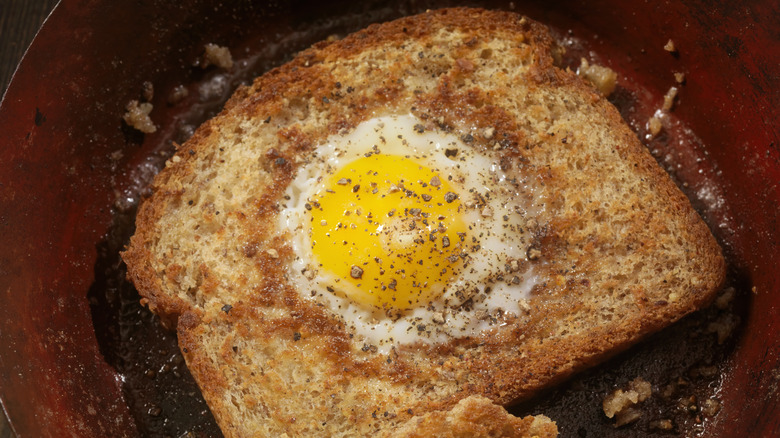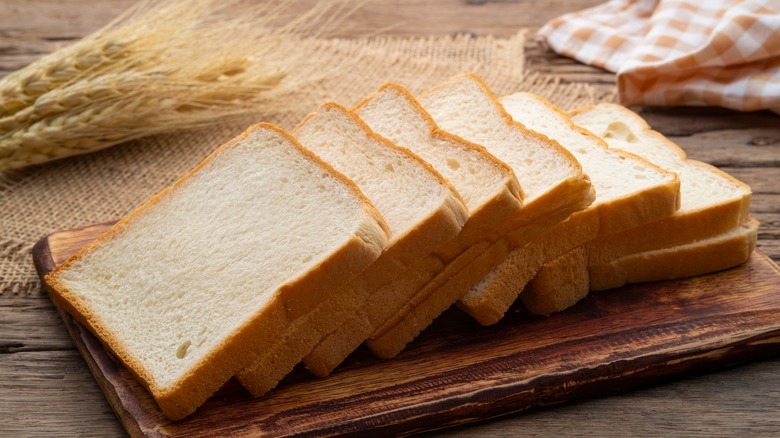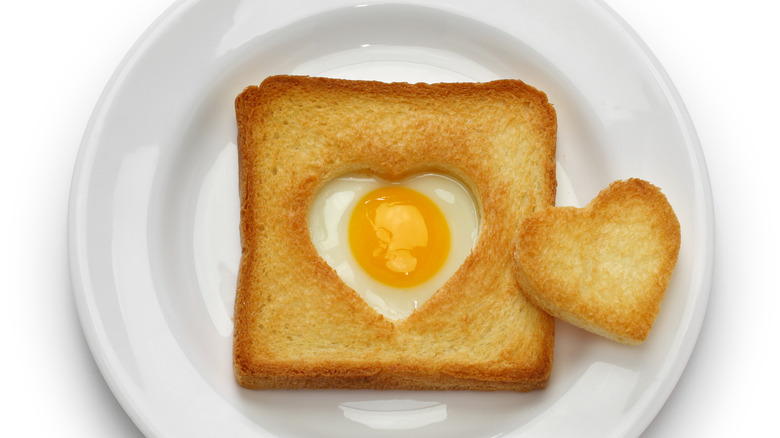Where Did The Breakfast Dish Egg-In-A-Hole Originally Come From?
If you want to feel like a kid again at breakfast, there's an easy shortcut: break out the sliced bread and an egg and make a few slices of egg-in-a-hole. This simple dish is just what it sounds like, bread with a hole cut out and an egg cooked in the hole. What kind of bread do you use? Any kind of bread you've got. Do you need any other special ingredients? Nope, just a fresh egg and a little bit of butter or oil to keep everything from sticking to the pan. But where did this magical breakfast come from? No, your parents and grandparents didn't invent it, even though you probably believed that for a least a while. Egg-in-a-hole is a recipe that started appearing in the U.S. around the 1890s, and it's been passed down through generations ever since.
Egg-in-a-hole goes by many names, which is probably one of the reasons why we might've grown up thinking that our parents or grandparents invented the dish. But whether you call it "basket eggs," "eggs with a hat," "bird-in-the-nest," or "toad-in-the-hole," this easy and satisfying dish has a long history of delighting kids, and kids at heart.
The first egg-in-a-hole
The exact origins of egg-in-a-hole are a little murky, but it seems to have been brought over to the U.S. by European immigrants (per Eater). Multiple cultures, it seems, were already making the dish, most notably Italians who made a version with peppers and tomatoes called "uova fritte nel pane." Its first official appearance with an American-sounding name, however, seems to be as a recipe for "eggs with a hat" in an 1890 printing of the "Boston Cooking School Cookbook" by Fannie Farmer.
After that, things likely really took off when sliced bread hit the grocery store shelves and took American kitchens by storm in the 1930s. It might seem commonplace now, but there was a time when bread was only sold as a whole loaf and you had to cut the slices yourself, hence the old saying, "It's the greatest thing since sliced bread." Once people could have a slice of bread anytime, all one needed to do was pop a hole out of the slice with a cup or cookie cutter and add an egg. The only exception was the time during WWII when sliced bread was briefly banned.
An egg by any other name
What trips people up when trying to trace the origins of egg-in-a-hole is the myriad of names. My Recipes identified at least 66 in 2018, but if you were to peruse any comments section on a recipe or scroll through where cooks hang out on social media, there are many more. It seems like part of the tradition is to come up with new names for the same dish.
"We call it a 'Walter Winchell,'" said one commenter on The New York Times. Another grew up calling it "frog in the pond." Over on Reddit, one person said, "I know that it makes absolutely zero sense, but in my family, we call it 'hole in the egg.'" And another added, "Different family members called it a 'frog in the hole,' 'egg in a basket' or 'toad hole.'" Don't, however, confuse it for the British recipe for "toad-in-a-hole," which is made with sausage and a popover.
Whatever you call it, egg-in-a-hole is a classic that will never get old. With only three steps, you can have breakfast on the table in less than 10 minutes using either the stove or your oven. And if you want to make up a whole new name for your family, go for it, because it's all part of the fun.


